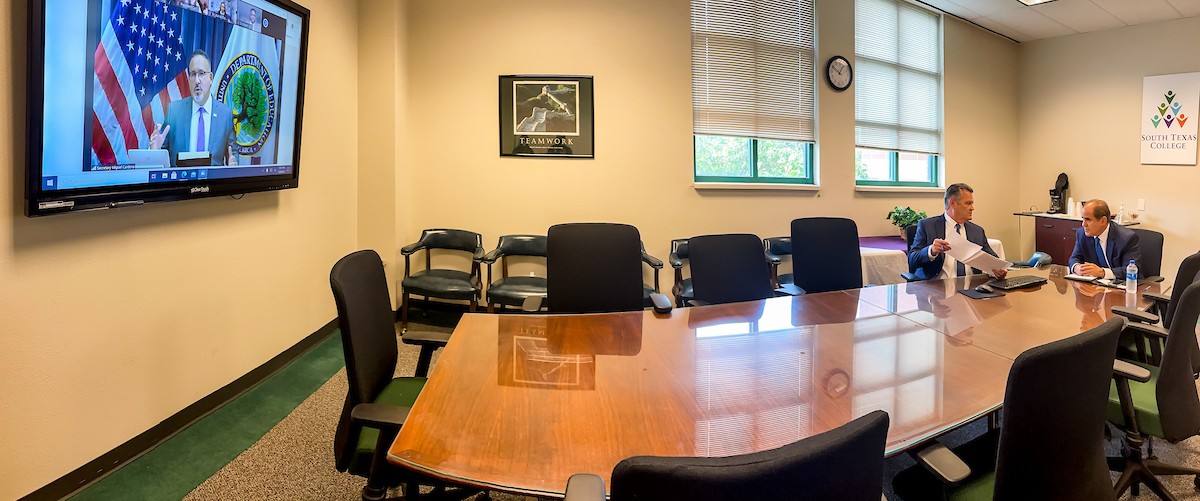STC pandemic efforts lauded by U.S. Dept. of Education
Secretary of Education Miguel Cardona engages STC leadership at virtual roundtable discussing best strategies during COVID
South Texas College President Dr. Ricardo J. Solis and Dr. David Plummer, STC Vice-President of Information Services, Planning & Strategic Initiatives joined U.S. Secretary of Education Miguel Cardona for a virtual roundtable July 29 discussing the use of Higher Education Emergency Relief Funds (HEERF) Supplemental Funding.
South Texas College has caught the attention of Education leadership in Washington, eyeing the college’s outreach with students during the height of the current COVID pandemic.
STC President Dr. Ricardo J. Solis and Dr. David Plummer, STC Vice-President of Information Services, Planning & Strategic Initiatives joined U.S. Secretary of Education Miguel Cardona for a virtual roundtable July 29 discussing the use of Higher Education Emergency Relief Funds (HEERF) Supplemental Funding.
Recognizing that “equity and student-centered services are in your institutional DNA” the meeting was a chance for the secretary to hear how funds allowed the college to continue to meet student needs. The roundtable was also a way to explain how HEERF funds have helped community colleges serve their communities just as much as their students, according to USDE.
Participating in the virtual roundtable was Dr. Guy Generals, President of Community College of Philadelphia; Dr. Karrie G. Dixon, Chancellor of Elizabeth City State University in North Carolina; and Carla Sineway, President of Saginaw Chippewa Tribal College in Mount Pleasant, MI.
“It should come as no surprise that the institutions that have long dedicated themselves to serving these communities were also among the hardest hit,” Cardona said in the roundtable. “It is your response to the challenges…you did whatever you could to support our students in need.
“Your institution has been used to doing more with less for years, and it’s almost like we have normalized that, unfortunately,” Cardona added. “It is long past time for this to end, and we are hopeful that the allocation of funds is a step in the right direction.”

“It should come as no surprise that the institutions that have long dedicated themselves to serving these communities were also among the hardest hit. It is your response to the challenges…you did whatever you could to support our students in need."
Secy. Cardona recognized STC for its efforts to re-engage students through its enrollment campaign and the expansion of the college’s mental health program to support student needs using HEERF funds.
“You (STC) are a perfect example of how we need to think differently,” Cardona said. “I have visited colleges across the country and I have met people who were trying college for the first time. These people are in their 50s or 60s who say ‘I want to rethink a lot of things and I want to take care of me and I want to go back to school to do something’.
“I met this person recently who had a heart attack but survived it and now decided to go back for a degree to help people who have poor health because they found their purpose in life,” Cardona said. “These are the students we have to capture now, and I see that you (STC) are setting the infrastructure to do that.”
U.S. Congressman Vicente Gonzalez announced more than $175 million in emergency funding for institutions in the Rio Grande Valley under the American Rescue Plan in May. STC received nearly $74 million of those funds, which it then applied for numerous strategies in order to assist students through the worst of the pandemic.
Most recently, the college has enabled students to apply for a $1,700 cash award to offset the cost of their tuition and fees for fall 2021, essentially giving students a “free semester” in order to return to college.
Following a decision by South Texas College Board of Trustees in June, STC also eliminated the debt of 3,488 students with unpaid balances from recent semesters, which included over $1.9 million in outstanding student balances.
Through its “Power Up” campaign, STC has also distributed emergency relief funds directly to students in the form of grants in order to provide financial assistance to those experiencing unforeseen hardships.
STC also added several new positions during the pandemic in order to enhance student support services. This included financial aid support specialists and admissions specialists tasked with working with those students hardest hit by the pandemic.
“We are very appreciative of the HEERF program, and the opportunity that it has brought to us. Today is a defining moment,” Dr. Solis said in the roundtable. “These funds have not only assisted our mission, but it has assisted in defining and transforming our mission, and really the mission of all community colleges including those in southern United States and along the U.S.-Mexico border.
“These funds have been an incredible asset in assistance to the community colleges, especially those that have been devastated by the pandemic,” he said. “We certainly wish to continue utilizing these funds to bring our students back, and more importantly to be able to address the needs in this economic recovery in the United States.”



